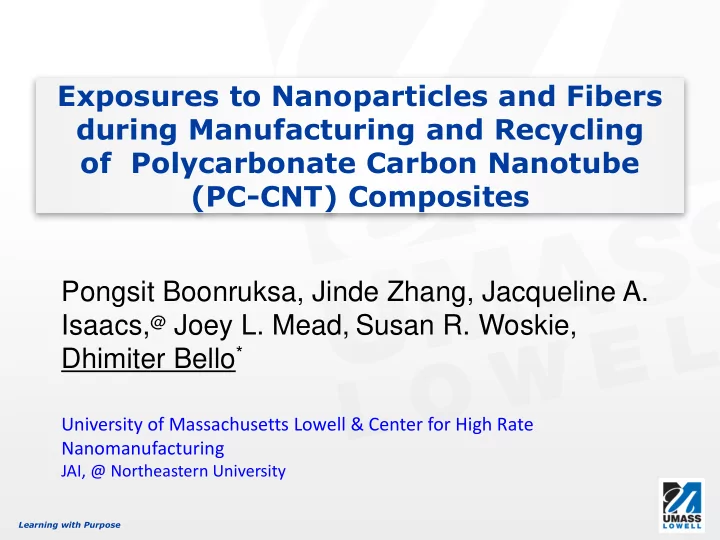

Exposures to Nanoparticles and Fibers during Manufacturing and Recycling of Polycarbonate Carbon Nanotube (PC-CNT) Composites Pongsit Boonruksa, Jinde Zhang, Jacqueline A. Isaacs, @ Joey L. Mead, Susan R. Woskie, Dhimiter Bello * University of Massachusetts Lowell & Center for High Rate Nanomanufacturing JAI, @ Northeastern University Learning with Purpose
Ref. : Nanoposts.com. The global market for carbon nanotubes to 2015: a realistic assessment. Available from: http://www.reportbuyer.com/publishers/2961/nan oposts.html. Learning with Purpose
Why we care about CNTs… NIOSH REL: 1ug/m 3 as EC CNTs are NOT a single entity. They represent a diverse BSI, 0.01 f/cm 3 class of materials with different physicochemical and morphological (PCM) and toxicological properties. IARC Intentional or incidental modifications of such PCM properties may have a profound impact on their MWCNT-7 , 2B - intrinsic hazard. - Others, G3 Figure 10.3 Bohner J. pg 218; In: Wohlleben et al edit’s, 2015 Learning with Purpose
Where could exposures (to CNTs) occur? M. Dahm, NIOSH 4 Schulte P et al., 2009: Occupational risk management of engineered nanoparticles. Learning with Purpose
Project Overview CNT-COMPOSITES ALONG THEIR LIFE CYCLE POST- SYNTHESIS END-OF-LIFE PROCESSING • PP-CNT vs. PP • Sawing, Cutting • Recycling (Grinding) • PC-CNT vs. PC • Drilling • Incineration • Epoxy-CNT vs. • Weatherization (PD, Harvard) Epoxy TOXICITY PERFORMANCE EXPOSURE Learning with Purpose
OBJECTIVES • Assess Airborne NP and CNT exposures: – Injection molding (IM) of PC-CNT & PC Composites – Grinding (for recycling) • Evaluate the impact of recycling on emissions Learning with Purpose
Process diagram and sampling locations Learning with Purpose
Methods Instrumentation Real time Integrated Sampling Characterization off-line Characterization Number Concentration FMPS, APS (p/cm 3 ) Size distribution FMPS, APS ( dN/dLogDp, p/cm 3 ) Learning with Purpose
Methods Instrumentation Real time Integrated Sampling Characterization off-line Characterization Morphology (source) ESP TEM 200-mesh Cu with C film Morphology (BZ) and Fiber count Nucleopore, 0.4 um Filters SEM Learning with Purpose
TPNC Emissions: Injection Molding a Raw data (log transformed) for reporting GM, GSD; P/B ratio = Process/background ratio of (GM, particles/cm3); b Statistically significantly higher than background (p <0.05), calculated from AUTOREG procedure in SAS; c p-value calculated from the linear trend weighted GM of background and S.E. Learning with Purpose
TPNC Emissions: Grinding a Raw data (log transformed) for reporting GM, GSD; P/B ratio = Process/background ratio of (GM, particles/cm3); b Statistically significantly higher than background (p <0.05), calculated from AUTOREG procedure in SAS; c p-value calculated from the linear trend weighted GM of background and S.E. Learning with Purpose
Particle size distribution: Injection Molding (IM) µm µm • Predominantly NPs (5.6 nm -0.56 µm) • Multimodal - (coagulation + process differences) • Limited influence by recycling #, R • Fine PM fraction was negligeable • SVOCs – condensation nano aerosols µm Learning with Purpose
Particle size distribution: Grinding • Dominated by NPs (5.6 nm - 0.56 µm). • Bimodal distributions – 10 nm and 30 nm • Grinder influences SD (grinder µm #1 – coarse powder) • Limited impact of recycling number R on SD • Fine PM present, but low (~1 um, <30 p/cm 3 ) µm Learning with Purpose
TEM Particle Morphology Loading Melting Molding Grinding #1 Grinding #2 Learning with Purpose
Particle morphology at PBZ during Grinding Learning with Purpose
Respirable Fibers at the PBZ During Grinding Respirable fibers are defined as having an aspect ratio ≥3:1, a diameter < 3 µm, and length > 5 µm; Short fibers are defined as having an aspect ratio ≥3:1, a diameter < 3 µm, and a length ≤ 5 µm . Learning with Purpose
Conclusions • Processing and grinding of PC/CNT composite generate significant airborne NPs, up 100x above background (Grinding) • No free CNTs were released • Respirable fibers (0.13 ff/ cm 3 ) & CNT protrusions • R (# recycling cycles) did not appear to significantly influence NPs exposures – understandable • Exposure controls should be instituted during synthesis and processing of PC/CNT • Further research is needed to elucidate the chemical composition of NPs, CNT content encapsulated in airborne particle and their toxicological properties Learning with Purpose
Acknowledgement NSF grants 120329 and 0425826 Dr. Arthur Miller, NIOSH for the ESP Dr. Earl Ada of UML material Characterization laboratory for the supervisions of TEM and SEM analysis Learning with Purpose
Thank You for Your Attention! Questions? Dhimiter_Bello@uml.edu Learning with Purpose
CNTs and Health Concerns • Critical effects of CNT include: – pulmonary inflammation, pulmonary fibrosis and granulomas (high respect ratio) – Genotoxicity (mutations and DNA damage) – Carcinogenicity (mesothelioma, needle-like shape) – Oxidative stress (Lam et al., 2006; Aschberger et al, 2010; Liu et al., 2012) • Changing parameters of CNTs such as shape, charge, solubility, surface chemistry, aggregation results in very different toxicologic response (Wick et al., 2007; Warheit et al., 2007; Hsieh et al, 2012, 2013 ) Learning with Purpose
Workplaces that could involve exposures to CNTs • Workers are involved with CNTs Some Text throughout their lifecycle. • More chances to be exposed to CNTs, if control measures are inappropriate. • Limited research on NPs and CNTs emission during commercial manufacturing process, as well as recycling process. Schulte P et al., 2009: Occupational risk management of engineered nanoparticles. Learning with Purpose
Recommend
More recommend